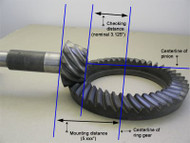Pinion Depth: Where Do I Start.....
Posted by DTA Sales on Mar 25th 2020
We get lots of questions about setting pinon depth so I wanted to come on and give some basics on what it is, how to measure it and where to start.
Definition: Position of pinion-gear relative to the ring-gear center-line, expressed as either a mounting distance (measured from behind the pinion head to the center-line of the ring gear) or a checking distance (measured from the face of the pinion head to the center-line of the ring gear).
Think of it as: How close the head of the pinion is to the center-line of the ring-gear. Proper pinion depth makes sure the pinion teeth mesh with the middle of the teeth on the ring-gear – between the top and the root. Increasing pinion depth moves the pinion closer to the center-line of the ring gear, moving the pinion “deeper” into ring-gear teeth and reducing the checking distance.
How Measured: The final determination of correct pinion depth can only be obtained by reading and interpreting the gear tooth contact pattern using gear-marking compound. There exist specialized tools for measuring pinion depth, but they are expensive, aren’t necessary, and are only used to calculate a starting point – final proof always lies in the contact pattern.
Adjusted Via: Inner pinion shims placed between the housing and the inner pinion-bearing cup. Adding shims moves pinion closer to ring-gear center-line, moving the pattern from the top to the root. Removing shims moves pinion further away from ring gear center-line, moving the pattern from the root to the top.
Note: When adjusting pinion depth, begin with a starting shim stack and make large adjustments at first (10-20 thou) until the correct setting is bracketed; then make progressively smaller adjustments until the final setting is achieved. Adding or subtracting a single shim of one thou can, and does, make a difference. Increasing pinion depth also decreases backlash and moves drive pattern slightly towards toe, and coast pattern slightly towards the heel. Decreasing pinion depth also increases backlash and moves the drive pattern slightly towards the heel, and the coast pattern slightly towards the toe. Increasing pinion depth will also increase pinion-bearing preload unless the outer pinion shims are adjusted.
Stay tuned for part 2 of this for blog on what the number etched on pinion gears really mean...


